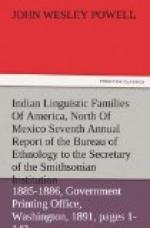From figures given by Rink, Packard, and others, the total number of Labrador Eskimo is believed to be about 2,000.
According to Holm (1884-’85) there are about 550 Eskimo on the east coast of Greenland. On the west coast the mission Eskimo numbered 10,122 in 1886, while the northern Greenland Eskimo, the Arctic Highlanders of Ross, number about 200.
Thus throughout the Arctic regions generally there is a total of about 34,000.
ESSELENIAN FAMILY.
< Salinas, Latham in Trans. Philolog.
Soc. Lond., 85, 1856 (includes
Gioloco?, Ruslen, Soledad, Eslen, Carmel,
San Antonio, and San Miguel,
cited as including Eslen). Latham,
Opuscula, 350, 1860.
As afterwards mentioned under the Salinan family, the present family was included by Latham in the heterogeneous group called by him Salinas. For reasons there given the term Salinan was restricted to the San Antonio and San Miguel languages, leaving the present family without a name. It is called Esselenian, from the name of the single tribe Esselen, of which it is composed.
Its history is a curious and interesting one. Apparently the first mention of the tribe and language is to be found in the Voyage de la Perouse, Paris, 1797, page 288, where Lamanon (1786) states that the language of the Ecclemachs (Esselen) differs “absolutely from all those of their neighbors.” He gives a vocabulary of twenty-two words and by way of comparison a list of the ten numerals of the Achastlians (Costanoan family). It was a study of the former short vocabulary, published by Taylor in the California Farmer, October 24, 1862, that first led to the supposition of the distinctness of this language.
A few years later the Esselen people came under the observation of Galiano,[38] who mentions the Eslen and Runsien as two distinct nations, and notes a variety of differences in usages and customs which are of no great weight. It is of interest to note, however, that this author also appears to have observed essential differences in the languages of the two peoples, concerning which he says: “The same difference as in usage and custom is observed in the languages of the two nations, as will be perceived from the following comparison with which we will conclude this chapter.”
[Footnote 38: Relacion
del viage hecho por las Goletas Sutil y
Mexicana en el ano de 1792.
Madrid, 1802, p. 172.]
Galiano supplies Esselen and Runsien vocabularies of thirty-one words, most of which agree with the earlier vocabulary of Lamanon. These were published by Taylor in the California Farmer under date of April 20, 1860.




